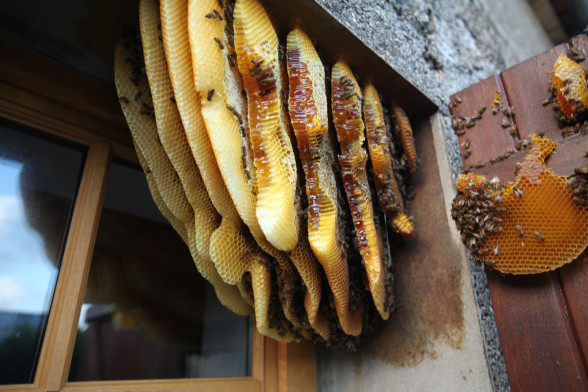
Bees /Apidae/
How do they look?
To gather nectar, bees have a long proboscis and tongue. They have antennae consisting of 13 segments for males and 12 segments for female bees. All bees have four wings, and their hind legs are smaller than the other legs. The stinger in bees has evolved into a stinger. The stinger is hidden in the abdomen while at rest. As the abdomen is highly mobile, the bee's sting is always precise. Bees, belonging to the Hymenoptera order, have a rich body covering of hair. The hind legs of worker bees have pollen baskets where they collect nectar.
Where do they live?
Bees can be solitary or form larger or smaller colonies. The most developed bees are those that form large colonies: honey bees, bumblebees, and solitary bees. In large colonies, there are queen bees, drones, and worker bees with well-defined tasks. Bee colonies are characterized by high organization with divided labor responsibilities.
Bumblebees, also belonging to the bee family, construct round nests using last year's grass stems. Nests are found in abandoned mouse burrows, under old barns, under leaves, and beneath stones.
Solitary bees, on the other hand, create nests in the cavities of plants such as reeds, but most often in tunnels in the ground.
What do they eat?
Bees feed on nectar and pollen; for bees, food primarily serves as an energy source, and only secondarily as a source of proteins and other substances. Bees nourish their larvae with bee bread made from pollen.
Interesting and important facts
Bees play a crucial role in pollination, serving as the primary pollinators in nature. The ancestors of bees were wasps, which are predatory. Parasitic bees, also known as cuckoo bees, behave similarly to cuckoo birds. These bee mothers lack the ability to collect pollen and build their own nests, so they infiltrate the nests of ‘normal’ bees, laying their eggs in the cells. Upon hatching, cuckoo bee larvae consume the host bee larva, if the mother has not already done so.
Information sources: Wikipedia, Kreslina L. ‘Insects in Latvia’
Photo: pixabay.com


